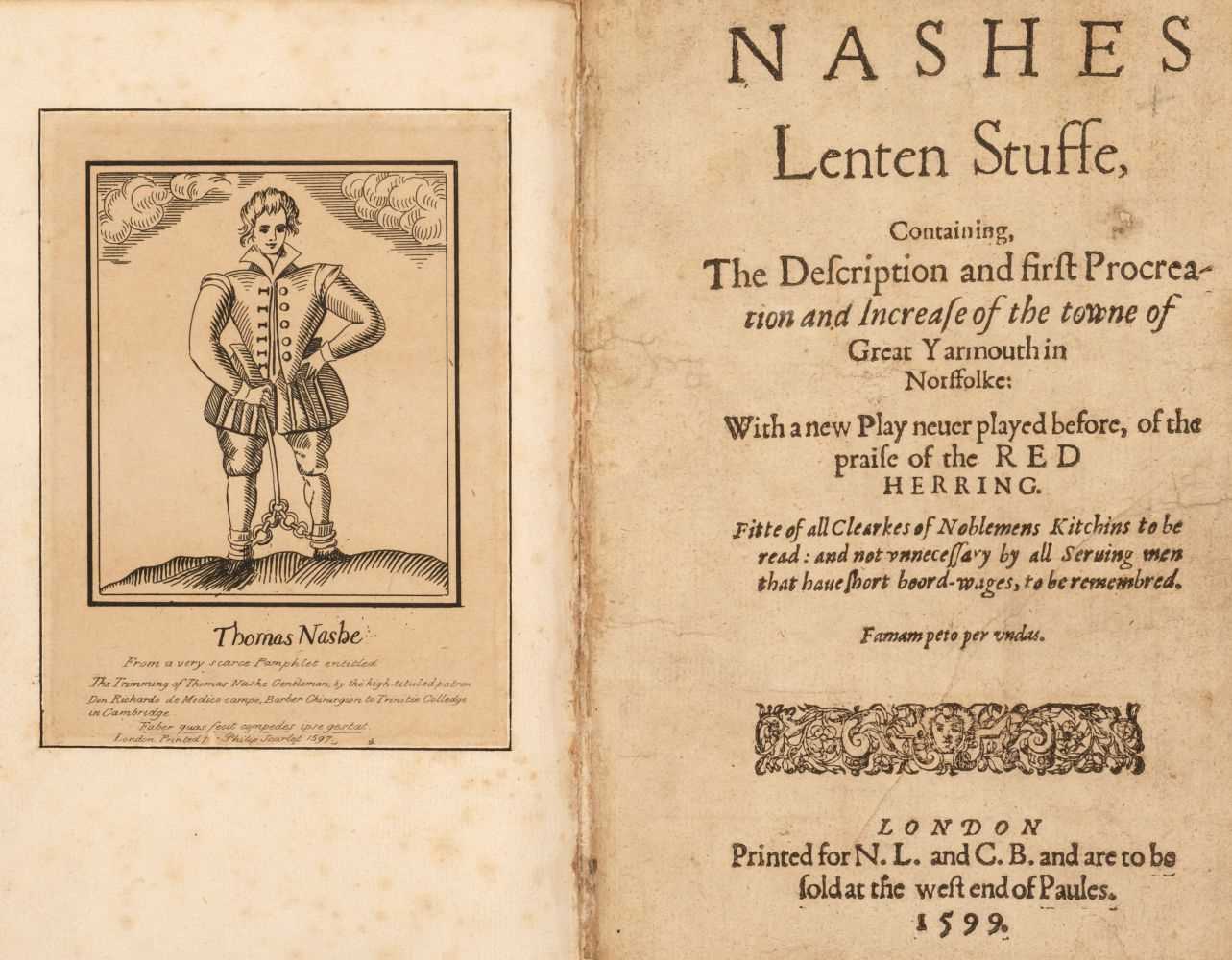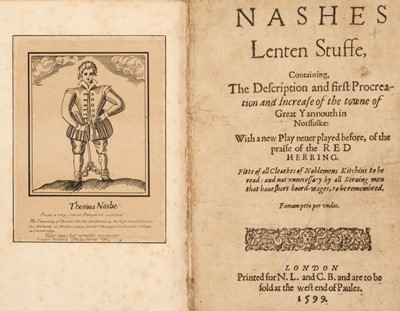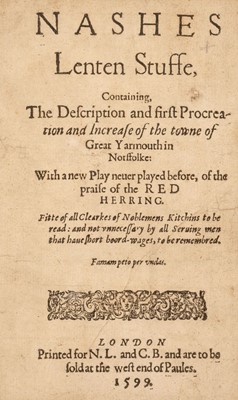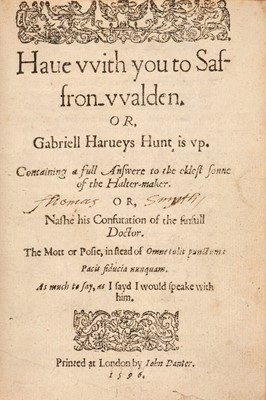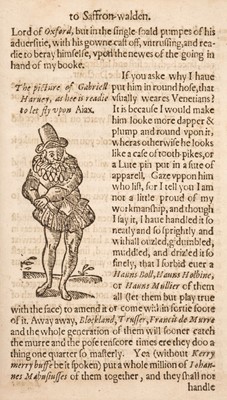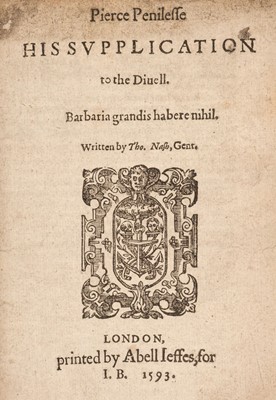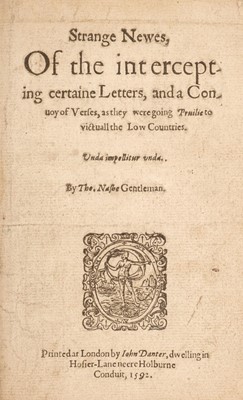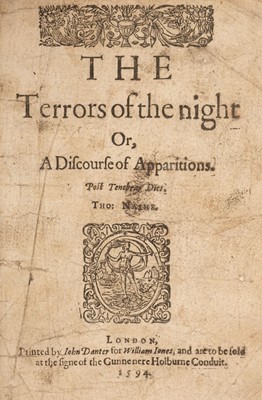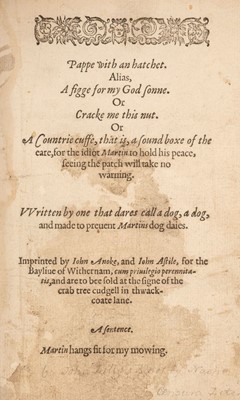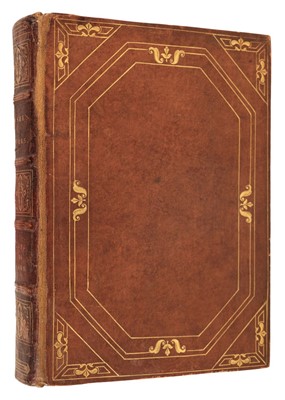25th Jan, 2023 10:00
Early Printed Books, English Literature & Fine Bindings, Maps, Prints & Documents
Nashe (Thomas, 1567-c.1601). A sammelband of 7 works, 1592-1600
Sold for £64,000
Nashe (Thomas, 1567-c.1601). A sammelband of 7 works, 1592-1600, comprising, in order: Nashes Lenten Stuffe, Containing, The Description and first Procreation and Increase of the towne of Great Yarmouth in Norffolke, 1st edition, 1599; Haue with you to Saffron-Walden. Or, Gabriel Harueys Hunt is vp, 1st edition, 1596; Pierce Penilesse His Supplication to the Diuell, 1593; Strange Newes, Of the intercepting certaine Letters, and a Conuoy of Verses, as they were going Pruilie to victuall the Low Countries, 1592; The Terrors of the night Or, A Discourse of Apparitions, 1st edition, 1594; [Attributed to John Lyly], Pappe with an hatchet. Alias, A figge for my God sonne, [1589]; A Pleasant Comedie, called Summers last will and Testament, 1600; all first or early edition issues published in London, all edges gilt, early 19th-century gilt-tooled calf, rebacked with original spine relaid, 4to (177 x 123 mm)
(Quantity: 1)
Additional material bound in:
A small portrait frontispiece of Nashe is mounted as frontispiece before the first title (19th-century reproduction from a 1597 original). At the start of the volume is a 4-page manuscript list of Nashe's works with notices of biographical accounts, written in a neat hand, probably by Robert Reeve, on laid paper with watermark of 'A. Smith'; a later manuscript note tipped in noting an account of Nashe's 2 plays published in the Retrospective Review for April 1828; this article copied in a neat contemporary hand and supplied on 3 part-folding pages at rear; a 4-page manuscript, in the same hand and on the same paper as the first list, giving a list of the volume's contents ('These have been long bound together in the same order'), and details of Nashe's works owned by the King's Library (24 items), the Marquis of Stafford (7 items), the Malone collection ('The Tragedie of Dido... by Christopher Marlowe and Thomas Nash Gent 1594'), the Garrick collection (Summers Last Will and Testament), the British Museum (6 items as referenced by Beloe's Anecdotes) and a final note by Reeve that 'Nash also wrote a play called "The Isle of Dogs” turned from a comedie into a tragedie. But it does not appear to have been printed.'
Provenance: Thomas Smyth (possibly Sir Thomas Smyth of Hill Hall, Essex, c. 1602-1668): early name inscription to second title; Robert Reeve (died 1840), attorney-at law in Lowestoft, Suffolk: ownership inscription to front pastedown: ‘Robert Reeve, Lowestoft’; J[eremiah] J[ames] Colman (1830-1898) and his son Robert James Colman (1861-1946), of the J. & J. Colman mustard business, Norwich, Norfolk: armorial bookplates to front pastedown and front free endpaper.
An extraordinary, and possibly unique, sammelband of rare works by the legendary prose writer Thomas Nashe. The only comparable items identified are a handful of multi-pamphlet volumes offered at auction centred on John Lyly and the Marprelate controversy. This collection of seven works was apparently bound by the former owner Robert Reeve, circa 1820, who notes that the items had been together in this order long since before he owned them. The missing two leaves in the final work are supplied in printed ‘facsimile’ and appear to have been specially set by Reeve at the time of binding; as such these two leaves are probably unique. For more information concerning editions and issue points the standard reference is the 5-volume works edition edited by Ronald B. McKerrow, 1904-10, with extra information obtained from ESTC, STC and Pforzheimer.
Thomas Nashe (or Nash) was an Elizabethan playwright, poet, satirist and pamphleteer. He is often considered the most brilliant and inventive prose writer of Elizabethan England. His subject range was wide as demonstrated in these seven works here. It is thought he collaborated with his friend Christopher Marlowe on Dido, Queen of Carthage, Ben Jonson on The Isle of Dogs (now lost) and Shakespeare on the Henry VI plays. In pamphlets such as Pierce Penniless he was involved in a defence of the Church of England. He was attracted to the Martin Marprelate controversy by his hatred of puritanism, being employed by the bishops to write against the works of fictional character Martin Marprelate. His lengthy and vicious quarrel with Gabriel Harvey was instrumental in defining English prose style and became so troubling that the authorities closed down the printing presses and issued a life ban on writing to both Harvey and Nash (1599).
Nashes Lenten Stuffe (1599) was Nashe’s last work and written after he went on the run from the London authorities following the furore surrounding a performance of his and Ben Jonson’s Isle of Dogs (1597). Have with You to Saffron-Walden was a response to Gabriel Harvey during their lengthy feud. Pierce Penniless contains an attack on both Richard Harvey, the astrologer and the Marinist, who, as part of the Marprelate controversy, had been waging a pamphlet war attacking the episcopacy of the Anglican church. Strange Newes contains Nashe’s fierce response to Harvey’s demolition of the recently deceased writer, Robert Greene. In The Terrors of the Night Nash sceptically considers dreams, nightmares, and apparitions, which he considers born of superstition, melancholy or imagination. Pappe with a hatchet is now believed to have been written by John Lily, though its inclusion here leaves open the idea that Nashe may have had some involvement in it, and besides it is one of the pamphlets in the Marprelate controversy. The last item, Summer’s Last Will and Testament, is Nashe’s only extant solo-authored play, a comedy notable for breaking new ground in the development of English Renaissance drama.
'If Nashe is a "minor" author, or at any rate a flawed one, his stylistic influence was none the less major. His richly textured language is discernible in the comedies of Jonson and the journalism of Dekker, and is more subtly present in Shakespeare: in the Falstaff scenes, in the bitter clowning of Twelfth Night, and even in Hamlet. The inclusiveness of his pamphlets, their gossip and bric-à-brac, have made them a "granary for commentators" (Brydges, Restituta, 1815, 2.359). They have, in the words of his great editor Ronald B. McKerrow (Works, 5.1), "a vividness of presentation which makes them more surely and entirely of their own time and country, more representative of the England of Elizabeth, than almost any others". Their irrepressible humour stands out sharply against the backdrop of circumstances—poverty, censorship, imprisonment—in which they were written.' (Oxford Dictionary of National Biography online)
i.
Nashes Lenten Stuffe, Containing, The Description and first Procreation and Increase of the towne of Great Yarmouth in Norffolke: with a new Play neuer played before, of the praise of the Red Herring. Fitte of all Clearkes of Noblemens Kitchins to be read: and not vnnecessary by all Seruing men that haue short boord-wages, to be remembred, 1st edition, London: printed [by Thomas Judson and Valentine Simmes] for N[icholas] L[ing] and C[uthbert] B[urby], 1599, [8], 75, [1] pp., woodcut ornament to title, title cut down and relaid without text loss, B1 remargined and rehinged with some trimming of side-notes on both sides, B4 rehinged, both these leaves possibly supplied from another copy, side-notes shaved on E4v, F1r/v & F2v, pinhead burn-hole to F4 not affecting text, a few scattered (?)18th-century ink marginalia, pen trials and ink smudges
First edition. 42 leaves; A-K4 L2.
ESTC S113098; Pforzheimer 764; STC 18370.
ESTC lists 7 copies in the UK and 11 in North America. Only two complete copies have appeared at auction in the last 40 years.
Nashe was likely a major contributor to Shakespeare's Henry VI, part I, and he was a close friend of Marlowe. This is the first edition of Nashe's final work, a delirious display of verbal pyrotechnics that has led modern critics to comparisons with Samuel Beckett and James Joyce. He is the most ingenious and engaging of the great Elizabethan authors in his wordplay. The present work is variously a mock encomium of red herring; a parody of the chorographical literature then in vogue; and a burlesque of Hero and Leander (among many other things).
‘This attempt to “wring juice out of a flint” as Nashe calls the book in his dedication, though perhaps not so regarded by the reading public of that day as only one addition was published in Nashe’s lifetime, may now be very said to be the cleverest and most typically boisterous of all his works. During his exile from London Nash took refuge at Yarmouth and must have been hospitably received for the present book was written in order to repay the debt. It recounts the origin and development of that town with much flourish though yet with some regard for antiquarian accuracy and eulogises the herring fisheries which have made it important in a burlesque encomia.’ (Pforzheimer)
ii.
Haue with you to Saffron-Walden. Or, Gabriel Harueys Hunt is vp. Containing a full Answere to the eldest sonne of the Halter-maker. Or, Nashe his Confutation of the sinfull Doctor, 1st edition, London: printed by John Danter, 1596, [168] pp., engraved headpiece and ornament to title (small tear at lower margin), woodcut of Gabriel Harvey to F4r, closed tear repair to Q1 without loss of text, light damp stain to lower margins, 17th-century ownership signature of Thomas Smyth to title, lacks final blank
First edition. 79 leaves; A-X4 [-X4, blank].
ESTC S110085; Pforzheimer 763; STC 18369.
ESTC lists 6 copies in the UK and 9 in North America. Three copies are noted at auction, all with imperfections and all offered by Sotheby's in 1923, 1946 and 1955.
‘This book while not a formal reply to Harvey’s Pierce’s Supererogation [q.v.] was nevertheless written as a general attack upon Harvey occasioned by the failure of the proffered reconciliation of Christ's Tears [q.v.]. It was the last salvo in this quarrel which Nashe wrote before the order of Whitgift and Bancroft, 1st June 1599, stopped all further publication on the subject … Though sixteen other copies can be traced, two being imperfect, it is doubtful if another as large and clean as the present and having the final blank leaf could be found.’ (Pforzheimer).
The Pforzheimer copy is described as 7 1/2 x 5 1/2 inches [190 x 140 mm], though it is unclear if that is the size of the binding or the leaves. The leaves in the volume offered here have been trimmed to a uniform size of 177 x 123 mm (7 x 5 inches).
iii.
Pierce Penilesse His Supplication to the Diuell, London: Abell Jeffes for I[ohn] B[usbie], 1593, [72] pp., woodcut device to title and tailpiece ornament at end, mostly black letter, title and final page dust-soiled
36 leaves; A-I4.
ESTC S105646; STC 18374. McKerrow (Nash’s Works I pp. 137ff.) identifies 5 early editions, three issued in 1592, one in 1593 (as this copy) and one in in 1595.
Of the edition offered here ESTC locates only two copies, at the British Library and Corpus Christi College, Oxford University. Only three copies of all the early editions have appeared at auction, the most recent sold by Sotheby's in 1946, from the Frank J. Hogan Library, was a first edition of 1592 and described as one of only three known perfect copies. It was issued without Nash's consent or knowledge who disapproved of the long-winded title composed by the printer, so he arranged that Abel Jeffes should issue a second edition with the first seven words alone on the title. All the early editions are very rare.
iv.
Strange Newes, Of the intercepting certaine Letters, and a Conuoy of Verses, as they were going Pruilie to victuall the Low Countries, London: printed by John Danter, 1592, [92] pp., small woodcut device to title, some dust-soiling and light damp stain to lower margins, some occasional fore-edge fraying, first 4 leaves rehinged
46 leaves; A-L4 M2.
ESTC S110072; STC 18377a.
McKerrow (Nash’s Works I pp. 247ff.) only saw one edition of 1592 (McKerrow A) but noted that Collier printed his Works edition (1870) from a reissue of the first edition (McKerrow B), with a new title-page and a substituted passage in the ‘Epistle Dedicatorie’, ‘replacing a somewhat libellous one’. The layout of the title-page differs between these two editions. Line 4 shows different spellings ‘Priuilie’ (A) and ‘Pruilie’ (B), while A has a typographical ornament and no imprint details except the date; B has a printer’s woodcut device (the same as for Terrors of the Night) and the imprint and date as described. McKerrow identifies four editions of 1593 but had only seen the last two of these himself.
ESTC locates only one copy of this edition (Henry E. Huntington Library). No copies of any early edition have been traced at auction.
v.
The Terrors of the night Or, A Discourse of Apparitions, 1st edition, London: printed by John Danter for William Iones, 1594, [62] pp., woodcut ornament and small device to title, title dust-soiled, creased and torn with small loss to foremargin not affecting text, relaid, foremargin paper repair to A2 outside of text, occasional dust-soiling, old ink numerals to final leaf verso (blank), lacks final blank
First edition. 31 leaves; A-H4 [-H4, probably blank].
ESTC S110111; STC 18379.
The Shakespearean scholar and antiquarian, James Halliwell-Phillipps (1820-1889) considered Terrors of the Night the rarest of all Nash's works.
ESTC locates 2 copies in the UK and two in North America (British Library (damaged title[page and following leaf), St John’s College, Cambridge University, Folger Shakespeare and Henry E. Huntington Library), all without the final leaf H4, presumed blank. No copies traced at auction.
vi.
[Attributed to John Lyly]. Pappe with an hatchet. Alias, A figge for my God sonne. Or Cracke me this nut. Or A Countrie cuffe, that is, a sound boxe of the eare, for the Idiot Martin to hold his peace, seeing the patch will take no warning. Written by one that dares call a dog, a dog, and made to preuent Martins dog daies, [London]: Imprinted by John Anoke, and John Astile [i.e. Thomas Orwin], for the Bayliue of Withernam, cum priuilegio perennitatis, and are to bee sold at the signe of the crab tree cudgell in thwack-coate lane, [1589], [2], 4, [34] pp., woodcut headpiece to title, title partly stained and double-pinhead-size hole to right margin, a little scattered soiling and marginal pen marks, final blank present
20 leaves; A-E4 [E4 blank].
ESTC S94124; Pforzheimer 649; STC 17463.3.
Bond (Lily’s Works III pp. 388–92) distinguishes three early editions of this work, all with the same collation and all undated. This is 'Edition C': this issue has B2v line 26: 'abusde:'; D4v lines 11-12: 'next | book,shall be …’.
‘That this is not a case of simultaneous printing or of alterations made in the press seems assured since each of the eight copies examined belongs to one edition only, and does not contain any mixture of sheets. These editions appear to have been issued successively and, although it cannot be satisfactorily proved, probably in the order given by bond. Their respective time of issue, however, cannot even be conjectured. Of all the anti-Martinist tracts written by the professional pamphleteers this is the only one of which the authorship is not disputed … Of the three editions of this work some twenty-two copies can be located. Of these at least two besides the present belong to Edition A – the Douce copy at the Bodleian and one at Trinity College Cambridge.’ (Pforzheimer)
ESTC locates 5 copies of this edition, three in the UK, at Dr Williams’s Library, London, Bodleian Library, Oxford University, and The John Rylands Library, The University of Manchester; and two in North America, at Indiana University and Yale University, Sterling Memorial. Most recently, Sotheby's sold four varied condition copies of 1589 editions in 2015, remarkably, these were the first copies at auction since 1948.
vii.
A Pleasant Comedie, called Summers last will and Testament, London: Imprinted by Simon Stafford for Walter Burre, 1600, [60] pp., printer's woodcut device to title, blank [A1] bound after title, B2 & B4 missing but supplied from (unique?) early 19th-century typeset ‘facsimile pages’ on laid paper, marginal repair to foremargin of B3 not affecting text, signatures C3-4 cancelled (as always), closely trimmed at upper margin occasionally shaving running heads, a little spotting and soiling, some browning and marginal staining to final leaves
30 leaves; A2 B-H4 I2 [A1 blank after title; -B2,4, supplied with 19th-century settings of the same leaves; -C3,4, cancels]
ESTC S110081; Greg I, 173; Pforzheimer 765; STC 18376.
This copy has Walter Burre’s Christian name corrected in the imprint (found as ‘Water’ in the some copies, including the Pforzheimer copy). The Pforzheimer copy is noted as lacking the first, presumed blank, leaf, found in this copy after the title as [A]2. Sig F is signed D with correction F stamped in below right; sigs F2-4 are signed D2-4. Sig B3 is found unsigned in some copies but is signed in this copy. As with all extant copies sigs C3-4 are cancelled, there being no known explanation.
ESTC lists 6 copies (including variant) in the UK and 8 in North America. Christie's offered a fine copy of the first edition with title in uncorrected state in 2004; prior to that the only two auction copies noted were those offered by Anderson Galleries in 1918 and 1923, though it is believed the Huth copy (Sotheby's sales, 1911-20) sold for £186 and the Christie-Miller copy (Sotheby's sales, 1916-27) sold for £250.
‘The present is the only unaided play by Nashe extant and appears to have been written for private performance before Archbishop Whitgift at Croydon in the fall of 1592. Dr McKerrow suggests that it may have been revised for a later performance before Elizabeth but Sir Edmund Chambers disposes of that possibility somewhat conclusively and, further, shows that it may well have been produced by members of Whitgift’s household rather than by a professional company. The ‘Summers’ of the title is of course Will Sommers, the jester of Henry VIII to whom there are frequent references in English literature for more than a century after his death in 1560 … Sixteen copies can be traced of which all but five are in public collections.’ (Pforzheimer)
You can make a purchase at Dominic Winter Auctioneers by using any of the following methods:
In person: Being present at the auction provides the convenience of being able to remove the lots that you have purchased when the sale ends, provided you choose to pay by credit or debit card, guaranteed cheque or cash.
Online bidding: You can bid live online at our auctions via our own website (dominicwinter.co.uk) after completing the registration process or alternatively you can live bid on the-saleroom.com or invaluable.com
Please note successful bids made via live bidding cannot be invoiced or paid for until the day after an auction. A live bidding fee of 3% + VAT (Dominic Winter website or Invaluable.com) or 4.95% + VAT (the-saleroom) will be added to your invoice.
Commission bid: Also called an 'Absentee bid'. A member of our staff will bid on your behalf and attempt to purchase the lot as cheaply as is permitted by other bids or reserves. Commission bids can be posted, faxed or emailed to us (please remember to provide your full name and address), or you can enter a bid on our website after completing the registration process.
Telephone bid: You can contact our office to arrange a telephone bid. A member of our staff will telephone you a few minutes before bidding commences on your specified lot and will bid on your behalf, according to your instructions. This service is only available on lots with a minimum pre-sale estimated value of £300.
Auction: Early Printed Books, English Literature & Fine Bindings, Maps, Prints & Documents, 25th Jan, 2023
To see a page-turning version of our catalogue, please see the Virtual Catalogue.
Dominic Winter (Auctioneers) Ltd
Conditions Of Sale And Business
Terms and Conditions of Sale
1. (a) Dominic Winter (Auctioneers) Ltd ("the Auctioneer") sells as agents for the seller (except where otherwise stated) and as such is not responsible for any default by buyer or seller.
(b) The Seller warrants to the Auctioneer and to the buyer that he is the true owner or is properly authorised to sell the property by the true owner and is able to transfer good and marketable title to the property free from any third party claims.
2. (a) The highest bidder to be the buyer. If during the auction the Auctioneer considers that a dispute has arisen he has absolute authority to settle it or to re-offer the lot. The auctioneer may at his sole discretion determine the advance of bidding or refuse a bid, divide any lot, combine any two or more lots or withdraw any lot without prior notice.
(b) Where goods are bought at auction by a buyer who has entered into an agreement with another or others that the other or others (or some of them) shall abstain from bidding for the goods and the buyer or other party or one of the other parties is a dealer as defined in the Auctions (Bidding Agreements) Act 1927 and 1969 the buyer warrants that the goods are bought bona fide on a joint account.
3. The buyer shall pay the price at which a lot is knocked down by the Auctioneer to the buyer ("the hammer price") together with a premium of 20% except those lots asterisked (*) in the title, in which case the buyer's premium is 24% inclusive of VAT. By making any bid the buyer acknowledges that his/her attention has been drawn to the fact that on the sale of any lot the Auctioneer will receive from the seller commission at its usual rates in addition to the said premium and assents to the Auctioneer receiving the said Commission.
4. (a) The buyer shall forthwith upon the purchase give his name and permanent address together with proof of identity and pay the Auctioneer immediately after the conclusion of the auction the total sum due.
(b) The buyer may be required to pay down during the course of the sale the whole or any part of the total sum due, and if he fails to do so after such request the lot or lots may at the Auctioneer's absolute discretion be put up again and resold immediately.
(c) The buyer shall at his own expense take away any lot or lots purchased no later than five working days after the auction day.
(d) The Auctioneer may at his discretion agree credit terms with a buyer and extend the time limits for collection in special cases but otherwise payment shall be deemed to have been made only after the Auctioneer has received cash or funds by bank transfer or a sterling banker's draft or the buyer's cheque or debit/credit card payment has been cleared.
(e) All sums due to the Auctioneer shall be paid as shown and he reserves the right to charge interest which shall accrue at the rate of 4% over such base lending rate of National Westminster Bank Plc as shall be in force at the date that interest becomes due, such sum to be calculated per annum from day to day on all amounts due but unpaid. This right shall be exercisable without prejudice to any other right of the Auctioneer.
5. (a) If the buyer fails to pay for or take away any lots pursuant to clause 4 or breaches any other condition of that clause the Auctioneer as agent for the seller shall be entitled after consultation with the seller to exercise one or other of the following rights:
(i) Rescind the sale of that or any other lots sold to the buyer who defaults and re-sell the lot or lots whereupon the defaulting buyer shall pay to the Auctioneer any shortfall between the proceeds of that sale after deduction of costs or re-sale and the total sum due. Any surplus shall belong to the seller.
(ii) Proceed for damages for breach of contract.
(b) Without prejudice to the Auctioneer's rights hereunder if any lot or lots are not collected within five days or such longer period as the Auctioneer may have agreed otherwise, the Auctioneer may charge the buyer a storage charge up to £1.00 per lot per day.
6. (a) The seller shall be entitled to place a reserve on any lot and the Auctioneer shall have the right to bid on behalf of the seller for any lot on which a reserve has been placed. A seller may not bid on any lot on which he has placed a reserve.
(b) Where any lot fails to sell, the Auctioneer shall notify the seller accordingly. The seller shall make arrangements either to re-offer the lot for sale or to collect the lot and may be asked to pay a commission not exceeding 50% of the selling commission and any special expenses incurred in cataloguing the lot.
(c) If such arrangements are not made within seven days of the notification the Auctioneer is empowered to sell the lot without reserve by auction or by private treaty and to receive from the seller the normal selling commission and special expenses.
7. Any representation or statement by the Auctioneer in any catalogue, brochure or advertisement of forthcoming sales as to authorship, attribution, genuineness, origin, date, age, provenance, condition or estimated selling price is a statement of opinion only. Every person interested should exercise and rely on his own judgement as to such matters and neither the Auctioneer nor his servants or agents are responsible for the correctness of such opinions. No warranty whatsoever is given by the Auctioneer or the seller in respect of any lot and any express or implied warranties are hereby excluded.
8. (a) Notwithstanding any other terms of these conditions, if within fourteen days of the sale the Auctioneer has received from the buyer of any lot notice in writing that in his/her view the lot is a deliberate forgery and within fourteen days after such notification the buyer returns the same to the Auctioneer in the same condition as at the time of the sale and satisfies the Auctioneer that considered in the light of the entry in the catalogue the lot is a deliberate forgery then the sale of the lot will be rescinded and the purchase price of the same refunded. "A deliberate forgery" means a lot made with intention to deceive.
(b) A buyer's claim under this condition shall be limited to any amount paid to the Auctioneer for the lot and for the purpose of this condition the buyer shall be the person to whom the original invoice was made out by the Auctioneer.
9. Lots may be removed during the sale after full settlement in accordance with 4.d. hereof.
10. All goods delivered to the Auctioneer's premises will be deemed to be delivered for sale by auction unless otherwise stated in writing and will be catalogued and sold at the Auctioneer's discretion and accepted by the Auctioneer subject to all these conditions. In the case of miscellaneous books, maps and other items, the Auctioneer reserves the right to extract and dispose of items that, in the opinion of the Auctioneer at his absolute discretion, have no saleable value and, therefore, might detract from the saleability of the rest of the lot and the Auctioneer shall incur no liability to the seller in respect of the items disposed of. By delivering the goods to the auctioneer for inclusion in his auction sales each seller acknowledges that he/she accepts and agrees to all the conditions.
11. (a) Unless otherwise instructed in writing, all goods on the Auctioneer's premises and in his custody will be held insured against the risk of fire, burglary, water damage and accidental breakage or damage. The value of the goods so covered will be the hammer price, or in the case of unsold lots the lower estimate, or in the case of loss or damage prior to the sale that which the specialist staff of the Auctioneer shall in their absolute discretion estimate to be the auction value of such goods.
(b) The Auctioneer shall not be responsible for damage to or the loss, theft, or destruction of any goods not so insured because of the seller's written instructions whether caused by negligence or otherwise.
(c) Any liability of the Auctioneer for any claim arising from loss or damage of any kind in respect of goods whether caused by negligence or otherwise including any claims for compensation will be limited to the amount of insurance cover effected in accordance with the provisions of clause 11.a. above.
12. The Auctioneer shall remit the proceeds of the sale to the seller thirty days after the date of the auction provided that the Auctioneer has received the total sum due from the buyer. In all other cases the Auctioneer will remit the proceeds of the sale to the seller within seven days of the receipt by the Auctioneer of the total sum due. The Auctioneer will not be deemed to have received the total sum due until after any funds received from the buyer have cleared. In the event of the Auctioneer exercising his right to rescind the sale his obligation to the seller hereunder lapses.
13. In the case of the seller withdrawing instructions to the Auctioneer to sell any lot or lots, the Auctioneer may charge the seller a fee of 12.5% of the Auctioneer's middle estimate of the auction price of the lot withdrawn together with Value Added Tax thereon and any expenses incurred in respect of the lot or lots.
14. If, on collation, any named items in the catalogue prove defective, in text or illustration, the buyer may reject the lot provided he/she returns it within fourteen days stating the defect in writing. This however will not apply in the case of unnamed items, periodicals, autograph letters, manuscripts, music, maps, atlases, prints or drawings, nor in respect of damage to bindings, stains, foxing, marginal wormholes or other defects not affecting the completeness of the text, nor in respect of lack of list of plates, inserted advertisements, cancels or subsequently published volumes, supplements, appendices or plates or error in the enumerating of the plates, nor in respect of defects mentioned in the catalogue or announced at the time of sale.
15. The Auctioneer accepts no responsibility in connection with the commissioning of his staff to bid for any lots. Reserves, and commission bids given by telephone are accepted only at the sender's risk and must be confirmed in writing before the date of the sale. Lots will always be bought as cheaply as is allowed by other bids and such reserves as are on our books.
16. Buyers are advised that a storage charge of £1.00 per lot per day plus Value Added Tax at the current rate will be levied on all purchases not cleared within fourteen working days of the sale. After this period the buyer will be responsible for loss or damage.
17. Artist's Resale Rights ("Droit de Suite"). Lots marked with "AR" or another appropriate symbol and referenced as such in the catalogue are subject to the Artist's Resale Right law. The buyer agrees to pay the Auctioneer an amount equal to the resale royalty and the Auctioneer will pay such amount to the artist's collecting agent. Resale royalty applies where the Hammer Price is 1,000 Euro or more and the amount cannot be more than 12,500 Euro per lot.
The amount is calculated as follows:
Royalty For the portion of the Hammer Price (in Euro)
4.00% up to 50,000
3.00% between 50,000.01 and 200,000
1.00% between 200,000.01 and 350,000
0.50% between 350,000.01 and 500,000
0.25% in excess of 500,000
Invoices will be issued in Pounds Sterling. For the purposes of calculating the resale royalty the Pounds Sterling/Euro rate of exchange will be the European Central Bank reference rate on the day of the sale. Please refer to the DACS website www.dacs.org.uk for further details.
18. These conditions shall be governed by and construed in accordance with English Law.
Buyer's Premium :
The buyer's premium is 20%, except those lots asterisked (*) in the title for which Value Added Tax (VAT) will be added to the premium, resulting in a buyer's premium of 24% inclusive of VAT. Eligible items include manuscripts, prints, photographs, drawings, framed maps, paintings, pens and other objects which are subject to VAT at a rate of 20% on the buyer's premium as part of the Auctioneers Margin Scheme. VAT zero-rated items such as books, unframed maps and albums are not subject to VAT on the buyer's premium.
Live Auction Charges
An additional commission of 3% plus VAT (3.6% inclusive of VAT) on the hammer price is payable if you use the live auction bidding facility on the Dominic Winter Auctioneers website (dominicwinter.co.uk). This charge will be added to your invoice automatically.
An additional commission of 4.95% plus VAT (5.94% inclusive of VAT) on the hammer price is payable if you use the live auction bidding facility on the ATG Media website (the-saleroom.com). This charge will be added to your invoice automatically.
An additional commission of 3% plus VAT (3.6% inclusive of VAT) on the hammer is payable if you use the live auction bidding facility on the Invaluable website (invaluable.com). This charge will be added to your invoice automatically.
Payment (UK Buyers)
Payment is preferred by direct Bank Transfer to our bank account. Our bank details will be supplied to you with your invoice.
Payment can be made in cash at the Cashier's Office, either during or after the sale. Alternatively, you can pay by cheque (Pounds Sterling only), please allow 5 working days for the cheque to clear before collection of goods.
Credit or Debit Card payments will not be accepted by telephone unless by prior arrangement with the auctioneers. Card payments can be made in person at our premises but must be accompanied by relevant ID confirming address details. We do not accept payments by American Express.
Payment (Overseas Buyers)
Payment must be made by direct Bank Transfer to our bank account. Our bank details will be supplied to you on your invoice. No card payments will be accepted unless by special prior arrangements with the auctioneers. All transfers must state the relevant invoice number. The amount we receive must be the total due after currency conversion and the deduction of any bank charges (normally £7).
UK Shipping
We are not specialist shippers. Some items, such as framed & glazed or fragile goods, will require specialist handling and buyers will be asked to use Mailboxes or RF Shipping Ltd. (details below).
For non-fragile items and items of reasonably small size, we offer an in-house packing and shipping facility for UK buyers. When possible, purchases will be sent by either Royal Mail Special Delivery or DPD overnight service. The charge for this service is variable (£15 minimum per parcel) and will be added to your invoice. Please note shipments to the Highlands and Islands may require shipment by courier and may be more expensive. Please contact us for a quote before bidding.
For larger packages and fragile goods, we recommend Mailboxes, Pack & Send or RF Shipping Ltd who will collect fully paid-for purchases from us twice a week and liaise with the buyer direct. For more information please contact Sarah Ball by telephone on +44 (0)1285 860006 or email sarah@dominicwinter.co.uk. These companies will require payment direct for their services.
